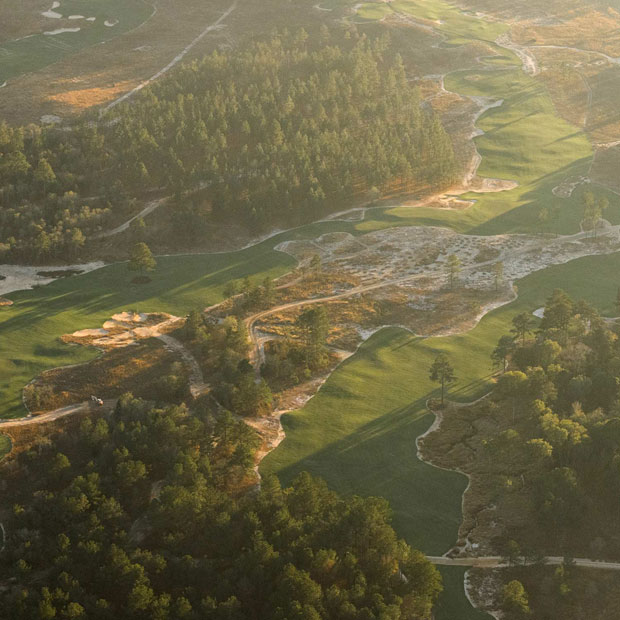Who Loves Replica Courses?
The strange appeal of golf courses built exclusively to imitate more famous properties


In the mind of the average recreational player, how many truly famous golf holes does the world have? Certainly two fit the bill: 17 at TPC Sawgrass and 12 at Augusta National. Probably the rest of Amen Corner merits inclusion. Toss in 7 or 18 from Pebble Beach. And the Road Hole at the Old Course. But after that, there are no no-brainers.
This is all to say that most people, even most golfers, do not have a dream 18. (That, readers, is the territory of people like you. Obsessives.) So, as I trekked around Renditions Golf Course in Maryland last spring, a related question was on my mind: who is this for?
Renditions is a replica course—every hole is a recreation of a piece of a different, more famous design. All of Amen Corner is featured, and so is Sawgrass’s island green, obviously. But the first hole on the course was one I was only somewhat familiar with: the 17th at Brookline. The second was an imitation of the par-3 12th from Inverness. The fifth was a par 5 from Royal Birkdale. Signs near the tee box on every hole gave short explainers on the history of the relevant course, or noted significant hazards—Oakmont’s third, with its church pews, popped up on Renditions’ back nine—but that didn’t do much for me or the buddies who had suggested the outing. It was hard to understand why playing a fake hole from Cherry Hills, which had made its most recent television appearance nearly 10 years prior as the host of the 2014 BMW Championship, would be any more exciting or illuminating or meaningful than just playing any old golf hole.
♢
Most sports—basketball, football, soccer—have tightly regulated playing grounds. When conditions change, even slightly, it’s usually a mistake. But even those that incorporate variable surfaces, like tennis or bowling, aren’t changing that much. A machine can change a bowling lane’s oil pattern. Novak Djokovic often practices at the New Jersey home of a wealthy coach who has courts that precisely imitate the surfaces of each major. Trying to replicate a golf course, visually, is hard enough. Getting everything else right is impossible.

The replica of TPC Sawgrass's 17th hole at Renditions Golf Course (courtesy of Renditions Golf Course)
I admit, however, that as I plotted my way around Fake Amen Corner, I was having a good time. But I also couldn’t help but note everything that seemed “wrong.” Augusta was not played on dormant Mid-Atlantic grass; the putting surfaces were still just like those at East Potomac; I wasn’t hitting out of the second cut but rather out of the regular old rough. I enjoyed the novelty of staring down the tee shot at Fake Sawgrass 17—on a windy day, I flushed two shots from the tee box and plopped them both in the water—but the rest of the course was more or less unrecognizable to me. It didn’t really matter, though. I was already there. The most famous fake holes had done their jobs.
♢
Are replica courses exercises in camp? I don’t write this to be condescending, but because I find them to occupy an artistic space that cannot be separated from the deliberately overboard: Elvis impersonators.
Hang with me. Templates are like cover songs: frameworks that still require artistic choices and some kind of unique spin if they are to be successful. My home course, Mt. Prospect, outside of Chicago, is a rare public template course that pays homage to its big (private) brothers in the area while still managing to be its charming self. (This is all in spite of the bizarre 17th, its Road Hole, which is, for my money, one of the worst holes in America.) Obviously no course on the planet is without inspiration and influences, but what value can there be in creation if no decisions are made?

Mt. Prospect Golf Club in Mount Prospect, Illinois. Photo: Andy Johnson
Elvis impersonators are not trying to convince you that the King is still alive and before you. They’re playing on tropes. Drawing you in with familiarity. Enticing you with comfort and a look and a name and perhaps a hint of irony. Nobody wants to go watch an average singer do an average set. But at the right place and time, an average singer with a sequined jumpsuit doing a rendition of “Hound Dog” might attract a crowd.
So it’s probably not surprising that there is a replica course in the home of the Elvis impersonator: Las Vegas. Bear’s Best consists of holes from only Jack Nicklaus-designed courses—a strange choice because Nicklaus didn’t design any truly famous holes.
My quick survey of replica courses across the country the only mainstays are Amen Corner, Sawgrass’s 17th, and maybe Oakmont’s church pews. Almost every other hole seems thrown in just to complete the concept. Random holes from the likes of Medinah No. 3, Inverness, Southern Hills, Merion, and Bay Hill pop up, but they don’t really matter. They’re filler. If you’re here, you just want to hit the island green.
♢
You might have been asking as you’ve read this, What about the Lido? Here’s what I think about Tom Doak and Mike Keiser’s grand project in Wisconsin: there’s an analogue for it, too.
There’s a Dutch band called, well, the Analogues. They are most easily described as a Beatles cover group, but that shorthand does them a disservice. They are obsessives. They’ve spent years listening to tracks in slow motion to identify easily missed quirks, poring over archival materials, scouring shops around the world for the precise instruments used on different recordings. Close your eyes as you listen to their rendition of “Penny Lane” and you’ll swear you’re hearing Paul’s voice and David Mason’s lips buzzing on the mouthpiece of that piccolo trumpet. What they are doing is not so much playing covers as making every possible effort to close the gap between what once existed and what exists now.
This is essentially the Lido’s project—to bring something, perfectly, exactly, back to life. That’s not quite the same thing that regular replica courses are trying to do. And with good reason. Recreating a course at its actual scale is something that is only feasible with some luck and sufficient topographical maps and a lot (a lot!) of money. The attraction is different, and targeted at a generally affluent group of people. It’s probably not possible to get the average golfer to care about a fully accurate reproduction of a lost C.B. Macdonald course, and only obsessives, whether or not they can afford it, will fork over hundreds of dollars to play it. How much would it be worth to hear John Lennon’s voice come from a place other than a speaker?
♢
So here is one last thing about replica courses: think about them long enough and they become a story about money.
Golf is about the places you can’t go. Of the 13 domestic holes featured at Renditions, 12 are from private courses. The only public course represented, TPC Sawgrass, has green fees starting at $600 during peak season. Most people, even the wealthy and the private-club members, will likely never get a chance to de-green themselves at Oakmont. It is unclear if Augusta National is even a real place or just some kind of annual collective hallucination. Implicit in a replica course is a question: don’t you want what they have?
Sometimes the answer is yes. But not without a little shame or confusion. And excitement, I guess, too. Not unlike how some people might have felt at one time while watching and hearing Elvis. And how they, presumably, hope to feel again, when they go to see somebody put on his jumpsuit.
Chris Almeida is a writer and editor whose work has appeared in Sports Illustrated and The Ringer.
Leave a comment or start a discussion
Engage in our content with thousands of other Fried Egg Golf Club Members
Engage in our content with thousands of other Fried Egg Golf Members
Get full access to exclusive benefits from Fried Egg Golf
- Member-only content
- Community discussions forums
- Member-only experiences and early access to events










Leave a comment or start a discussion
Lorem ipsum dolor sit amet, consectetur adipiscing elit. Suspendisse varius enim in eros elementum tristique. Duis cursus, mi quis viverra ornare, eros dolor interdum nulla, ut commodo diam libero vitae erat. Aenean faucibus nibh et justo cursus id rutrum lorem imperdiet. Nunc ut sem vitae risus tristique posuere. uis cursus, mi quis viverra ornare, eros dolor interdum nulla, ut commodo diam libero vitae erat. Aenean faucibus nibh et justo cursus id rutrum lorem imperdiet. Nunc ut sem vitae risus tristique posuere.